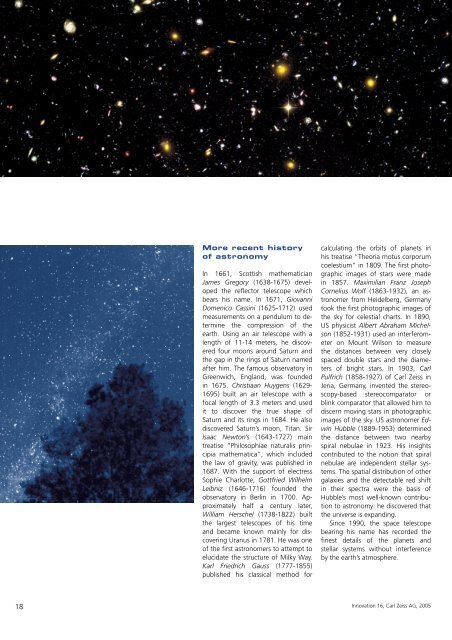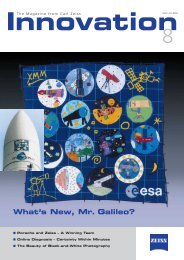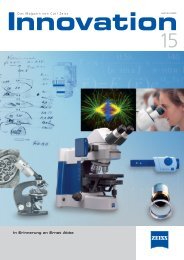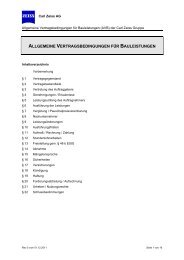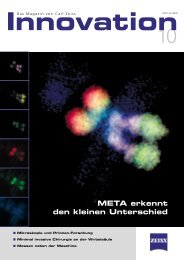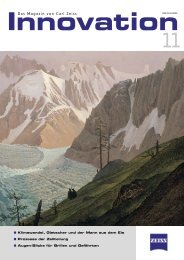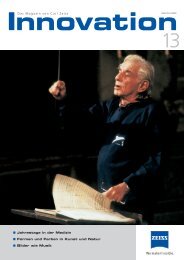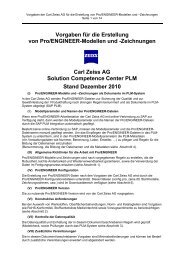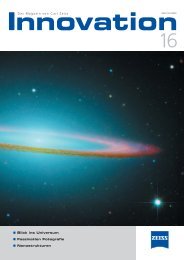Download PDF - Carl Zeiss
Download PDF - Carl Zeiss
Download PDF - Carl Zeiss
Create successful ePaper yourself
Turn your PDF publications into a flip-book with our unique Google optimized e-Paper software.
18<br />
More recent history<br />
of astronomy<br />
In 1661, Scottish mathematician<br />
James Gregory (1638-1675) developed<br />
the reflector telescope which<br />
bears his name. In 1671, Giovanni<br />
Domenico Cassini (1625-1712) used<br />
measurements on a pendulum to determine<br />
the compression of the<br />
earth. Using an air telescope with a<br />
length of 11-14 meters, he discovered<br />
four moons around Saturn and<br />
the gap in the rings of Saturn named<br />
after him. The famous observatory in<br />
Greenwich, England, was founded<br />
in 1675. Christiaan Huygens (1629-<br />
1695) built an air telescope with a<br />
focal length of 3.3 meters and used<br />
it to discover the true shape of<br />
Saturn and its rings in 1684. He also<br />
discovered Saturn’s moon, Titan. Sir<br />
Isaac Newton’s (1643-1727) main<br />
treatise “Philosophiae naturalis principia<br />
mathematica”, which included<br />
the law of gravity, was published in<br />
1687. With the support of electress<br />
Sophie Charlotte, Gottfried Wilhelm<br />
Leibniz (1646-1716) founded the<br />
observatory in Berlin in 1700. Approximately<br />
half a century later,<br />
William Herschel (1738-1822) built<br />
the largest telescopes of his time<br />
and became known mainly for discovering<br />
Uranus in 1781. He was one<br />
of the first astronomers to attempt to<br />
elucidate the structure of Milky Way.<br />
Karl Friedrich Gauss (1777-1855)<br />
published his classical method for<br />
calculating the orbits of planets in<br />
his treatise “Theoria motus corporum<br />
coelestium” in 1809. The first photographic<br />
images of stars were made<br />
in 1857. Maximilian Franz Joseph<br />
Cornelius Wolf (1863-1932), an astronomer<br />
from Heidelberg, Germany<br />
took the first photographic images of<br />
the sky for celestial charts. In 1890,<br />
US physicist Albert Abraham Michelson<br />
(1852-1931) used an interferometer<br />
on Mount Wilson to measure<br />
the distances between very closely<br />
spaced double stars and the diameters<br />
of bright stars. In 1903, <strong>Carl</strong><br />
Pulfrich (1858-1927) of <strong>Carl</strong> <strong>Zeiss</strong> in<br />
Jena, Germany, invented the stereoscopy-based<br />
stereocomparator or<br />
blink comparator that allowed him to<br />
discern moving stars in photographic<br />
images of the sky. US astronomer Edwin<br />
Hubble (1889-1953) determined<br />
the distance between two nearby<br />
spiral nebulae in 1923. His insights<br />
contributed to the notion that spiral<br />
nebulae are independent stellar systems.<br />
The spatial distribution of other<br />
galaxies and the detectable red shift<br />
in their spectra were the basis of<br />
Hubble’s most well-known contribution<br />
to astronomy: he discovered that<br />
the universe is expanding.<br />
Since 1990, the space telescope<br />
bearing his name has recorded the<br />
finest details of the planets and<br />
stellar systems without interference<br />
by the earth’s atmosphere.<br />
Innovation 16, <strong>Carl</strong> <strong>Zeiss</strong> AG, 2005


